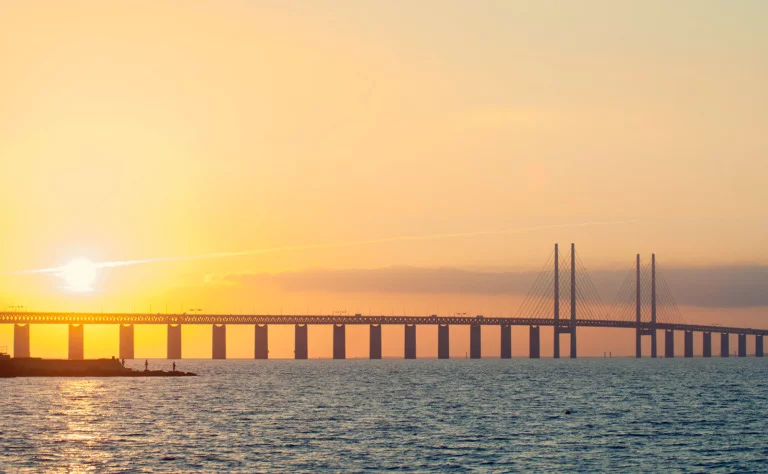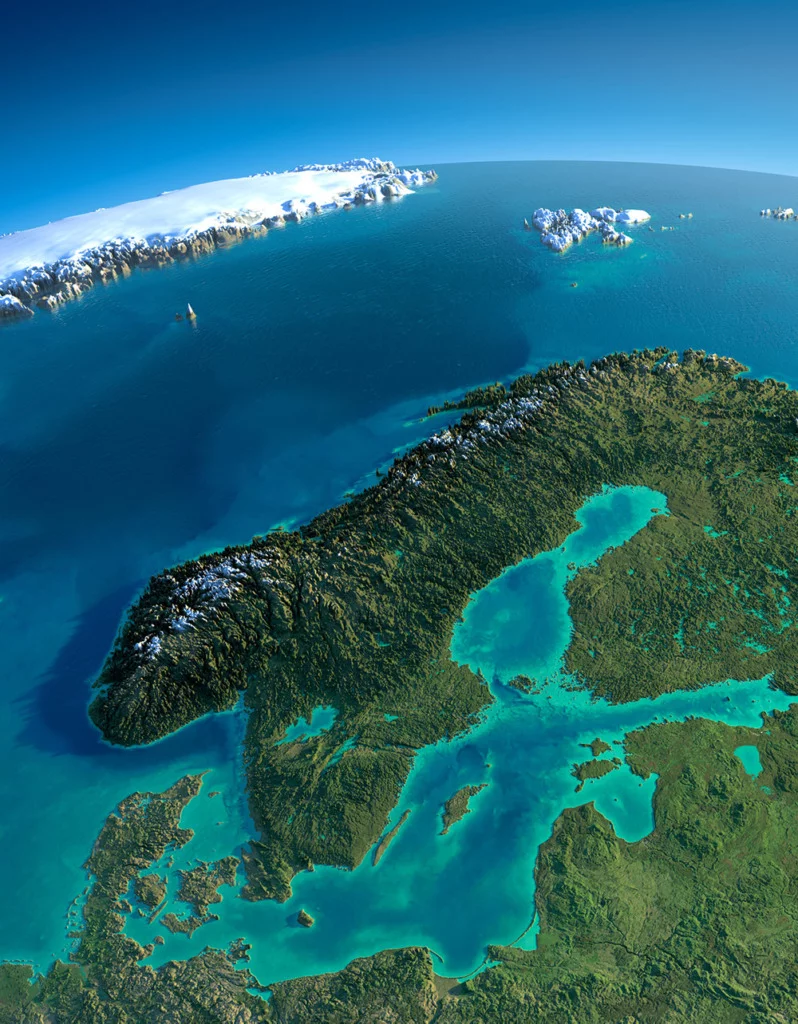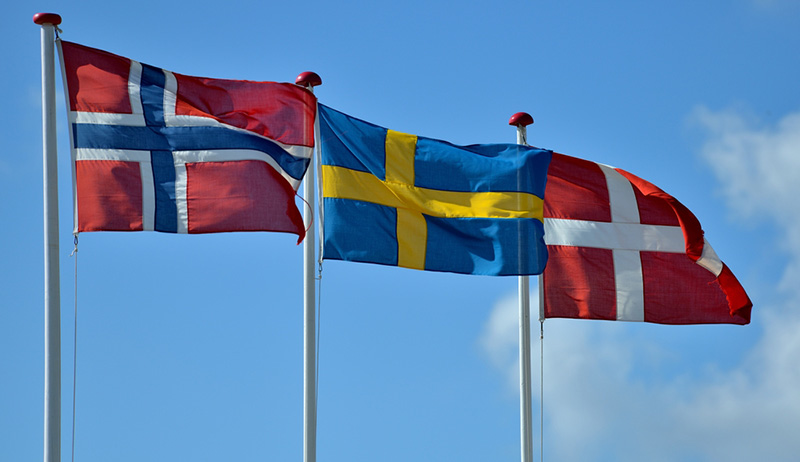Scandinavia is a region that evokes images of dramatic fjords, stylish cities, and a high quality of life. But beyond the stereotypes, what do the numbers reveal about life in this northern corner of Europe?
Statistics offer a fascinating glimpse into the realities of life in Scandinavia, from population trends and economic strength to social policies and environmental impact.

Previously, we’ve explored key stats about Norway, but now it's time to take a broader look at the region as a whole.
Before we dive in, let’s clarify the definition of Scandinavia used in this article. While the term is sometimes applied loosely to the entire Nordic region, we are focusing on the most common definition: Denmark, Norway, and Sweden.
This excludes Finland and Iceland, which, while Nordic, are not typically classified as part of Scandinavia. Now, let’s explore what the numbers tell us about this fascinating region.
Table of Contents
The Geography of Scandinavia
Scandinavia is a land of contrasts, shaped by its dramatic landscapes and diverse geography. While Norway and Sweden share the vast Scandinavian Peninsula, Denmark stands apart as a low-lying country of islands and farmland.
Norway and Sweden are defined by their populous southern cities—such as Oslo, Stockholm, and Gothenburg—while their northern regions stretch into vast, sparsely populated wilderness.
The Scandinavian Mountains form a natural border between the two countries, creating a rugged, dramatic terrain that dominates western Sweden and much of Norway.
While Norway is world-famous for its deep fjords and dramatic coastal scenery, Sweden’s landscape is characterised by dense forests, rolling hills, and thousands of lakes.

Denmark, however, is geographically distinct. Unlike its mountainous neighbours, it is predominantly flat and consists of the Jutland Peninsula and hundreds of islands, including Zealand (home to Copenhagen) and Funen.
With fertile, arable land, Denmark’s geography has shaped its history as an agricultural and maritime nation.
In terms of size, the total land area of the three Scandinavian countries combined is 878,435 km², broken down as follows:
- Denmark: 42,933 km² (excluding the Faroe Islands and Greenland)
- Norway: 385,207 km² (excluding Svalbard)
- Sweden: 450,295 km²
While Scandinavia might seem vast, its total land area places it behind countries such as Egypt, Mauritania, and Bolivia, all of which cover just over 1 million km².
However, with its varied landscapes, large uninhabited areas, and extreme seasonal changes, Scandinavia feels much larger than the numbers suggest.
Population of Scandinavia
Scandinavia is home to an estimated 22,174,784 million people, but the population is unevenly distributed across the region due to its varying geography and climate.
As of the end of 2024, the estimated populations of the three countries were:
- Denmark: 5,992,734
- Norway: 5,594,340
- Sweden: 10,587,710
These figures highlight Sweden’s position as the most populous Scandinavian country, with nearly twice the population of either Denmark or Norway.

However, population density paints an even clearer picture of how people are distributed across the region:
- Denmark: 137.65 people per km²
- Norway: 14.2 people per km²
- Sweden: 25 people per km²
Denmark is by far the most densely populated of the three, with the majority of its people concentrated in and around Copenhagen, Aarhus, and Odense. The country’s small size and relatively flat terrain allow for a more even spread of settlements compared to its Nordic neighbours.
In contrast, Norway and Sweden have large, sparsely populated areas, particularly in the north. Norway’s population is heavily concentrated along the southern coast, with Oslo and its surrounding areas being home to a significant portion of the country’s residents.
Sweden’s population follows a similar pattern, with most people living in the south, particularly in Stockholm, Gothenburg, and Malmö, while the vast forests and tundra of northern Sweden remain largely uninhabited.
Compared to the rest of Europe, Scandinavia has a relatively low population density, especially Norway, which has vast wilderness areas and one of the lowest densities in Europe. For comparison:
- The United Kingdom has a population density of around 277 people per km²
- Germany has approximately 233 people per km²
- France has around 119 people per km²
Scandinavia’s low population density, particularly in Norway and Sweden, contributes to its reputation for unspoiled nature, outdoor lifestyles, and vast open spaces. However, it also presents challenges for infrastructure, transportation, and service provision in remote areas.
Immigration Stats in Scandinavia
Scandinavia has long been shaped by migration, with foreign-born residents making up a significant portion of the population.

As of recent estimates, there are approximately 4.7 million immigrants (including children of immigrants) living across Denmark, Norway, and Sweden—accounting for 21% of the region's total population.
Here’s the breakdown by country:
- Sweden: 2,866,676 immigrants (27.1% of the total population)
- Denmark: 943,066 immigrants (15.7% of the total population)
- Norway: 931,081 immigrants (16.6% of the total population)
Among the three countries, Sweden has the highest proportion of foreign-born residents and children born to immigrants, largely due to its historical openness to refugees and economic migrants. Denmark has the lowest percentage, reflecting its stricter immigration policies in recent years.
Where Do Scandinavia’s Immigrants Come From?
The origins of immigrants in Scandinavia vary, reflecting historical ties, labour migration patterns, and asylum policies:
Sweden: The largest immigrant group comes from Syria, followed by Iraq, Finland, Poland, and Iran.
Denmark: The largest immigrant community is from Turkey, followed by Poland, Syria, Germany, and Romania.
Norway: The most significant immigrant group comes from Poland, followed by Sweden, Somalia, Lithuania, and Pakistan.
While immigration has contributed to Scandinavia’s cultural diversity and workforce, it has also been a topic of political debate, particularly in Denmark and Sweden, where discussions around integration, social services, and policy reforms remain ongoing.
The Cities of Scandinavia
While Scandinavia is often associated with nature, the majority of its population lives in urban areas. The three Scandinavian capitals—Stockholm, Copenhagen, and Oslo—are the largest cities in the region, each serving as a cultural and economic hub.

Comparing city populations can be tricky due to varying administrative boundaries, but clear differences emerge among the region’s largest cities:
- Stockholm is Scandinavia’s biggest city, with a population of 975,904, expanding to 1.6 million when including the broader urban area.
- Copenhagen follows with 794,128 residents, also rising to 1.6 million in the urban area.
- Oslo ranks third, with 697,549 people in the city proper and just over 1 million in the wider metropolitan area.
Beyond the capitals, Gothenburg and Malmö in Sweden are the next largest cities, followed by Aarhus in Denmark and Bergen in Norway.
Life Expectancy in Scandinavia
Scandinavia is renowned for its exceptional quality of life, characterised by robust social welfare systems, high educational standards, and comprehensive healthcare services.
These factors contribute to the region's impressive life expectancy rates, which are among the highest globally. As of 2023, the life expectancy at birth for the Scandinavian countries is as follows:
- Norway: 83.46 years
- Sweden: 83.33 years
- Denmark: 81.62 years
These figures surpass the European Union's average life expectancy of 80.6 years in 2022. The consistently high life expectancy across Scandinavia reflects the region's commitment to policies and lifestyles that promote health and well-being.
Crime Rates In Scandinavia
Scandinavia is often perceived as a region with low crime rates, reflecting its high quality of life and robust social systems. However, crime statistics vary across Denmark, Norway, and Sweden, influenced by factors such as urbanisation, socioeconomic conditions, and law enforcement practices.
Sweden
In recent years, Sweden has experienced an increase in certain types of violent crime, particularly those linked to gang activity.
Homicide Rate: The intentional homicide rate in Sweden has seen fluctuations, but the longer-term trend is on the increase. In 2013, there were 87 recorded homicides, compared with 121 in 2023.
Gun Violence: Sweden reported 53 shooting deaths in 2023, averaging one shooting per day per 10 million inhabitants. This marks a significant increase compared to previous years.

Denmark
Denmark and Norway continue to maintain relatively low crime rates. While Denmark has seen occasional concerns regarding gang-related violence, crime levels remain stable.
Homicide Rate: The intentional homicide rate in Denmark has seen fluctuations, but remains steady at between 40 and 60 over the past 10 years. In 2022, there were 55 homicides in Denmark.
Gun Violence: Gang-related shootings have dropped in Denmark in recent years. There were 18 and 21 deaths in 2022 and 2023 respectively, compared with the high of 87 in 2017.
Norway
Norway, in particular, reports some of the lowest crime rates in Europe, with consistent trends of low violent and property crime rates.
Homicide Rate: In 2023, the country recorded just 35 homicides, although that was significantly higher than the rolling ten-year average.
Gun Violence: In 2023, 11 people were killed in Norway in homicide cases involving firearms. The number of homicide cases in total and the number of cases involving firearms have remained relatively stable since 2014.
Despite recent challenges, Scandinavia remains one of the safest regions in the world.
Stats About the Scandinavian Languages
The languages Danish, Norwegian and Swedish all share a common history. Some people suggest the three are merely dialects of a common Scandinavian language.
However, put a Dane, Norwegian and Swede in a meeting and watch what happens! Chances are they will switch to English as a lingua franca.
Approximately 20 million people in the Nordic countries speak a Scandinavian language as their native language, a figure that includes an estimated 5% Swedish-speaking minority in Finland. Native speakers of Scandinavian languages outside the Nordic region are rare.
As Sweden has the biggest population topped up with the Swedish-speaking minority of Finland, it's no surprise that Swedish is the most used Scandinavian language.
The mutual intelligibility between the Continental Scandinavian languages is asymmetrical. Various studies have shown speakers of the Norwegian language to be the best at understanding other Scandinavian languages.
Travel Stats About Scandinavia
Copenhagen Airport once again leads the passenger numbers at Scandinavian Airports. In 2024, a total of 29,882,167 passengers used the biggest airport in Denmark.

Copenhagen Airport has topped the charts for many years now, aside from the pandemic years. When international travel was essentially paused, Oslo Airport topped the charts due to its significant domestic network.
In 2024, Oslo Airport handled 26,438,238 passengers, with Stockholm Airport Arlanda handling 22,757,911. The next busiest airport in the Scandinavian countries was Bergen Airport Flesland, which handled 6,552,286 passengers.
Scandinavian cruises have experienced a notable resurgence in recent years, with significant activity across Norway, Denmark, and Sweden. Here's an overview of cruise ship calls and passenger statistics for these countries in 2023 and projections for 2024:
Norway: In 2023, Norwegian ports recorded a total of 3,943 cruise ship calls, an increase of nearly 500 compared to the previous year. This surge brought over 6 million cruise passengers to Norway, setting a new record for the country's cruise industry.
Denmark: Danish ports received 503 cruise calls and 1,166,675 cruise guests in 2023. Notably, 33% of these calls included at least two Danish ports in their itineraries, and approximately 43% of all cruise guests were from Germany.
Sweden: In 2023, Swedish ports received 338 cruise ship calls, a decrease of 129 compared to 2022. However, the total number of cruise passengers increased by 7%, reaching 553,710.
These figures highlight the nuanced landscape of Sweden's cruise sector, where a reduction in ship calls was offset by higher passenger numbers, indicating a trend towards larger or fuller vessels.


